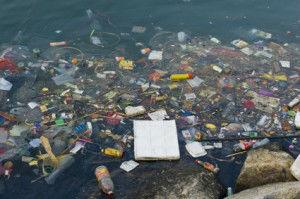
You’ve probably been told that seafood is an important contribution to a healthy diet. And for years this has rung true. Seafood is high in protein, healthy fats and allows for variety in a healthy eating plan (depending on preparation technique of course).
But a recent study found that you may be doing more harm than good by preparing that fresh catch regularly.
The study, published in Nature, Scientific Reports, touches on what we already know about fish and mercury content, but goes one step further by shedding light on the slew of chemicals fish absorb on a daily basis. The main culprit? Plastic.
Thousands of pounds of plastics wind up in our oceans every day. In fact, researchers estimate the weight of plastic that makes its way into the ocean each year is equivalent to that of 40 aircraft carriers.
This massive amount of pollution tends to congregate in one of five gyres around the world, one of the largest being the Great Pacific Garbage Patch in the Pacific Ocean. Not only do these gyres affect the surrounding ecosystems, but scientists are beginning to see how they affect us as well.
As plastics degrade, fish proceed to digest the smaller particles. In 2009, the Scripps Environmental Accumulation of Plastic Expedition found that fish living in the intermediate depths of the North Pacific Ocean ingest between 12 and 24 thousand tons of plastic annually.
This shouldn’t be surprising since the mass of plastic found throughout the various oceans exceeds that of plankton six times over. So where does this plastic ultimately end up? On your plate.
The study also found plastics in the ocean are not only harmful in and of themselves, but they act as a “sponge” for the slew of chemicals already present in the ocean. Study author, Chelsea Rochman compared the ocean waters to that of a “toilet bowl” for chemical pollutants and waste. The digestive juices of fish interact with these chemicals, allowing for quick absorption into their bloodstream, and ultimately ours.
During the study, fish consumed either a “clean” diet consisting of 10 percent plastic particles without contaminants or a diet in which the same plastics had been soaking in the San Diego Bay for several months. The fish who consumed the plastics that were soaking in the bay had much higher levels of toxins in their blood, as well as tumors and liver problems.
So do the benefits of consuming fish outweigh the risk? The consensus among many health professionals is that eating fish is still a healthy addition to the diet thanks primarily to their omega 3 content. Yet researchers are wary as they learn more about the pollutants building up among the fish population.
Even more alarming is the fact that a majority of our fish comes from foreign waters that the EPA doesn’t monitor for contamination. And because such a limited quantity of imported fish actually gets inspected, it’s easy to see why diets rich in seafood are no longer being considered a go-to for many health-conscious consumers.
 For now, your best bet is to limit seafood intake to two servings weekly and avoid the larger varieties, such as tuna, swordfish and mackerel. However, this won’t solve the greater problem of oceanic pollution. Unless we find a way to prevent further contamination, seafood dinners may soon become a health hazard rather than a healthy option.
For now, your best bet is to limit seafood intake to two servings weekly and avoid the larger varieties, such as tuna, swordfish and mackerel. However, this won’t solve the greater problem of oceanic pollution. Unless we find a way to prevent further contamination, seafood dinners may soon become a health hazard rather than a healthy option.
-The Alternative Daily
Sources:
http://www.npr.org/blogs/thesalt/2013/12/12/250438904/how-plastic-in-the-ocean-is-contaminating-your-seafood http://www.nature.com/srep/2013/131121/srep03263/full/srep03263.html
http://www.npr.org/blogs/thetwo-way/2012/05/09/152350088/study-plastic-garbage-in-pacific-ocean-has-increased-100-fold-in-40-years
http://serc.carleton.edu/NAGTWorkshops/health/case_studies/plastics.html
http://www.nrdc.org/health/effects/mercury/guide.asp

